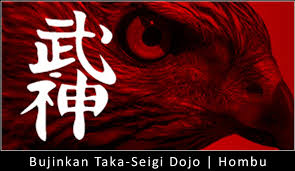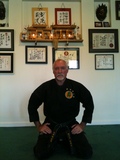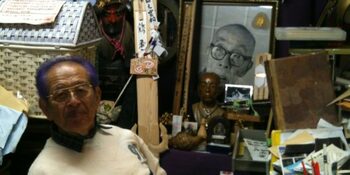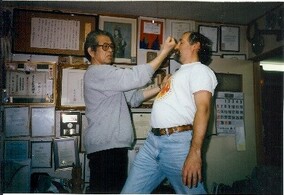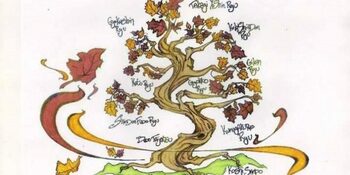
Budo Fitness
10.12.18
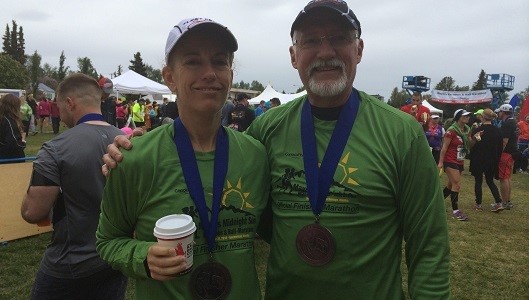
What is martial arts fitness? Is there a place for fitness in the Bujinkan? There have been arguments for/against this since I started training in the Bujinkan in 1977. Budo Fitness can be easily misunderstood. Most of us probably envision a lot of knuckle pushups, hundreds of kicks, split stretching and calisthenics at the beginning of class at a Mac-Dojo. I have seen a number of dojo that have a gym inside their facility and many of us may have taught our classes as part of a gym/fitness center. My first dojo here in Maryland was at the YMCA. They had a great gym that we could use before or after training. Most of the time we trained outside in the backyard of the Y. The picnic tables and trees and hills and the culvert were our gym. In the mid-90s I had an exercise and conditioning class that I taught before teaching my Bujinkan class. I got some grief from my senior black belts about that. They thought that in the Bujinkan you didn’t need to work out to be good — that taijutsu is not about power or strength, but about proper use of the body to be effective. It was about subtlety and being a “ninja”. I had to laugh at that, but they would point to Soke as the example. He never works out, they would say. It was hard for me to argue my point about fitness back then, but over the years I have come to my own understanding of what fitness means to me and its relation to martial arts and life. I’ve realized that fitness training is essential to good martial arts and a healthy and active life. I believe you CAN add fitness training to dojo training to improve your overall martial arts ability, as long as it is relevant. I offer these modest points on what fitness is and how it can be incorporated in the dojo for optimal training.
Flexibility: Tai sabaki. Stretching and yoga. There are basic stretches that even Soke does to warm up before class starts. However, being a Westerner, I have to work much harder at stretching my hips, knees and ankles than most Asians. This is due to Westerners using chairs to sit in vice sitting on the floor, and our propensity to drive everywhere rather than ride a bike or walk. Also for me, a lifelong runner, my hips are even more tight than most. So taking time to do basic stretching is key to Western martial artists staying flexible. I especially like power yoga, because its flexibility, deep breathing and strength training combined. Deep breathing has more than just physical benefits. Flexibility is also about expanding your mind. Opening up to new training, new teaching perspectives, new experiences, etc. I have learned a heck of a lot by hosting seminars, such as our black belt seminar and BuFestivus where other Shihan share in teaching.
Agility: Tai sabaki. Dynamic Ukemi and Sabaki. Dive rolls, leaps, kicks, cartwheels, handsprings, etc. Dynamic Te Sabaki climbing, being upside down, etc. Box jumping and climbing help develop agility and strength in specific areas to aid in having explosive and dynamic ukemi and sabaki. Warning: You first must develop impeccable ukemi before going into dynamic ukemi. Never have beginners dive rolling over objects or on hard surfaces until they have developed solid basic rolling and falling skills. The more flexible you are, the better agility you will have. The better in shape you are, the tighter your rolls are going to be and the less stress you will put on your joints.
Balance: Tai sabaki. Balance and core training. Standing on one leg/with eyes closed, rolling/walking in a straight line with eyes closed. Understanding your center-line. Know when you are in balance and how to auto-correct during movement when you are not. Ability to ground yourself. Balance beam, bosu ball, blind fold training or training in the dark all help to develop good sense of balance. Core training, such as Pilates, Yoga and Feldenkrais will give you your center-line and teach you to fire your core muscles to maintain balance. These will also teach you graceful movement. Studying a complimentary art, such as Qi Gong or Tai Chi Chuan is also a very big help. Having flexibility and agility will improve your balance and vice versa.
Power Generation: Tai sabaki. Power generation is about pulling it all together for a strong result. Not only punches and kicks, but with weapons too. Body alignment and activating your core are key to power generation. For a punch, align the fist with the wrist with the elbow and shoulder, then the spine to the hips to the knees and feet. For strong kicks, align the sole of the foot with the ankle with the knee with the hip, then across to the other hip with the supporting knee with the supporting ankle and to the standing foot. In both kicks and punches the spine and neck should be straight and in alignment with both the pelvis and the head. Being flexible, agile, in balance and grounded are the keys to power generation. All aspects of fitness come together here to give you a strong punch and kick. Focus mits and heavy bags are great training to power generation. Warning: Do not have beginners punching and kicking heavy bags until they develop proper form and alignment. Students can sprain wrists/ankles or break bones hitting heavy and hard objects with poorly formed punches and kicks. Add weapons to power generation to develop strong striking form. Practicing bo strikes on a heavy bag develops power in your strikes and also requires flexibility, agility and balance.
Stamina: Being able to deliver powerful strikes, dynamic Ukemi and Sabaki over a period of time. Continuous leaping, rolling, in and out of stances, punching and kicking combos, ukemi combos, constant sparring, Sen no endo, En no endo, Ichimonji drills with light weights, etc. Adding weapons is great too. Doing bo furi with a weighted bar, sword cutting with a tsuburito. Incorporating interval training (very little rest between various exercises or routines) is a great way to develop stamina and endurance. Whatever you do needs to be real to your martial arts otherwise you are building stamina for something you will never need or do, so keep it real to your martial arts and your life.
[Note: You can’t run to the battle only to be too tired or fatigued to fight. Marine Corps figured that out a long time ago and has all Marines take both a periodic Combat Readiness Test and a Physical Fitness Test. The latter is a run, pull ups and sit ups. This is a great measure of your overall strength and condition. Training for this test helps us to keep that “Poster Board Marine” look. However, it does not measure your ability to fight under combat conditions, with combat equipment and as part of a combat team. The Combat Readiness Test is a whole other thing for measuring a Marine’s battlefield fitness by testing activities, such as carrying a wounded brother off the battlefield, while in full combat gear (both of you), low crawling in gear, passing full ammo cans to a machine gunner, etc.]
Having said all this, fitness, just like Bujinkan training, needs to be done as much outside the dojo as within (if not more, in order to develop your total fitness level). For myself, I run 2-3 days a week and do strength/core training 5 days a week. My typical work outs on run days are: Stretch then run 3-5 miles which usually includes 1-2 sprints uphill and jog back down in the middle, then stretch again, 1-2 sets of pull-ups, 1-2 sets of lateral cable pulls (inside and outside of arms), 1-2 sets of triceps pull downs, 1-2 sets of cable curls, 1-2 sets of combo dumbbell curls and military press, 1-2 sets of kettle bell swings,1-2 sets of kettle bell goblet squats, 1-2 sets of dumbbell flies on incline bench, a set of pushups, a set of leg raisers and knee raisers (on the pull up bar or on a dip bar), a set of ab rollers, finish with stretching and using a myofacia roller. Typical work out on strength/core training days are a short warm up on the elliptical machine (usually about 20-25 minutes) followed by all of the above strength exercises, but 2-3 sets of each with varying weights. Joanne does a lot of similar core and strength exercises to include more of the Pilates/floor core drills (like V ups) and she does the hellish Turkish getups like nobody’s business. She also does one-legged pistols and box jumps. My knees aren’t able to take these last two any more.
In BTSD training we have optional physical fitness requirements for students to develop a baseline understanding of their overall fitness level. I incorporate push ups, pull ups, sit ups, and running as a way to measure general fitness. These can all be practiced outside the dojo. Stretching, core training, yoga, and interval training are also incorporated in my workouts outside the dojo, but I do this to varying degrees in the dojo as well. Combining outside fitness training with dojo fitness training will be a great benefit to your overall health and will exponentially increase your abilities in the dojo.
The BTSD Instructor Manual has the optional physical fitness requirements for 7th kyu, 5th kyu, 3rdkyu and Shodan for the students to strive for. These requirements start off relatively easy, but as the student progresses in rank they become harder and work the student up to this final level. Not all students can do these, nor are they required to. These are for those students who would like to develop and maintain a physical fitness baseline.
BTSD Optional Fitness Requirements for Shodan are:
Men:
- 7 pull ups/3chin ups without dismounting the bar
- 70 sit ups in 2 minutes
- 50 knuckle push ups and 20 finger push ups with a 1 minute rest between
- 3 mile run/walk in 30 minutes or less
Women:
- 3 pull ups/1 chin up without falling off the bar (can be assisted)
- 70 sit ups in 2 minutes
- 10 knuckle push ups and 15 regular push ups with a 1 minute rest between
- 3 mile run/walk in 30 minutes or less
Fitness is a whole package; physical, mental and emotional/spiritual. When we get stronger, more flexible and are in balance, we gain confidence in our body’s ability to perform. Gaining confidence allows you to slow down and remain calm. Remaining calm is key to seeing the entire situation and gives you options. Having options allows you to disengage or defuse a situation before it is even a situation. You life becomes richer for it.
I had a great golf coach once who came up with the 7 principles of golf to transform your game and transform your life.
Darrin Gee’s Seven Principles of Golf (and Life):
- First Principle – Get Grounded. Quiet the mind. Ground your body. Find your center.
- Second Principle – Develop Feel. Slow down. Make the connection. Go with your gut.
- Third Principle – Visualize the Shot. Know what you want. Believe in it. See it happen.
- Fourth Principle – Create Your Own Ritual. Create rituals. Find your own space. Honor it daily.
- Fifth Principle – Find Your Natural Swing. Trust your instincts. Find your own way. Be yourself.
- Sixth Principle – Play One Shot at a Time. Turn off the auto-pilot. Be present now. Surrender to the moment.
- Seventh Priniciple – Transform Your Golf Game, Transform Your Life. Trust the process. Embrace the journey. Transform your life.
To me it’s the same with fitness. Transform your body, transform your Taijutsu and transform your life. I hope this article on Budo Fitness is useful to you. Welcome your comments and feedback.
For the absolute best video references for training in the Bujinkan please check out our website: www.takaseigi.com where you will find current video martial arts instruction by many Bujinkan Shihan and myself, plus rare authorized footage of Hatsumi Soke, Noguchi Sensei and Nagato Sensei.
Phillip Legare
Dai-Shihan, Bujinkan
Budo Taijutsu and Shinken
“Strength through Proper Training”
